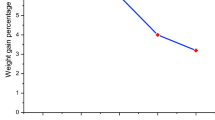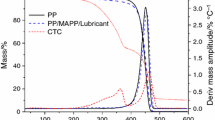Abstract
They were analyzed the thermal and rheological behavior of several varnishes and paints, used for wood protection, available on the market. The thermogravimetric analysis coupled with mass spectrometry and Fourier transform infrared spectrometry technique revealed that the degradation mechanism is complex and includes two to five decomposition stages depending on the composition. The analysis of the gases resulting from the decomposition processes of the water-based samples showed that carbon dioxide was the main potentially harmful product, whereas for those containing solvent these harmful agents were as follows: benzene, xylene and carbon dioxide. The decomposition of the sample containing urea-alkyd resins also results in hydrocyanic acid. The rheological tests showed a viscoelastic solid behavior in the case of water-based film-forming products, and a viscoelastic liquid behavior in the case of solvent-based ones. The microscale combustion calorimetry technique confirmed that this sample has the lowest thermal stability and can contribute the most to the triggering of fires.
Graphic abstract









Similar content being viewed by others
References
Crespi MS, Hikosaka MY, Amaral G, Ribeiro C (2007) Kinetic parameters obtained for thermal decomposition of acrylic resins present in commercial paint emulsions. J Therm Anal Calorim 88:669–672
Deka A, Dey N (2013) Rheological studies of two component high build epoxy and polyurethane based high performance coatings. J Coat Technol Res 10:305–315
Duce C, Bernazzani L, Bramanti E, Spepi A, Colombini MP, M.R. (2014) Tiné Alkyd artists’ paints: Do pigments affect the stability of the resin? A TG and DSC study on fast-drying oil colours. Polym Degrad Stabil 105:48–58
Eley RR (2005), Applied rheology in the protective and decorative coatings industry, Rheology Reviews 172–240.
Gawdzik B, Rogulska M, Grochowicz M, Osypiuk-Tomasik J (2019) Studies of thermal properties of di(methacryloyloxymethyl)naphthalene–divinylbenzene (DMN–DVB) copolymer and its alkyl-bonded derivatives. J Therm Anal Calorim 138:4385–4393. https://doi.org/10.1007/s10973-019-08150-7
Germinario G, van der Werf ID, Sabbatini L (2016) Chemical characterization of spray paints by a multi-analytical (Py/GC–MS, FTIR, μ-Raman) approach. Microchem J 124:929–939. https://doi.org/10.1016/j.microc.2015.04.016
Guo X, Ge S, Wang J, Zhang X, Zhang T, Lin J, Zhao CX, Wang B, Zhu G, Guo Z (2018) Waterborne acrylic resin modified with glycidyl methacrylate (GMA): Formula optimization and property analysis. Polymer 143:155–163
Hester RD, Squire DR (1997) Rheology of waterborne coatings. J. Coat. Technol. 69:109–114
Hof F, Schäfer RA, Weiss C, Hauke F, Hirsch A (2014) Novel λ3-Iodane based functionalization of synthetic carbon allotropes (SCAs) – common concepts and quantification of the degree of addition. Chem Eur Journal 20:16644–16651
Jiao L, Xiao H, Wang Q, Sun J (2013) Thermal degradation characteristics of rigid polyurethane foam and the volatile products analysis with TG-FTIR-MS. Polym Degrad Stabil 98:2687–2696. https://doi.org/10.1016/j.polymdegradstab.2013.09.032
Jin E, Chung Y-J (2016) Combustion characteristics of pinus rigida specimens treated with mixed phosphorus-nitrogen additives. J Ind Eng Chem 36:74–79
Jodeh S, Chakir A, Massad Y, Roth E (2020) Assessment of PM2.5, TVOCs, comfort parameters, and volatile organic solvents of paint at carpenter workshop and exposure to residential houses in Deir Ballout in , Int. J. Environ. Sci. Technol. https://doi.org/10.1007/s13762-020-02877-9
Lin TS, Cogen JM, Lyon RE (2007) Correlations between microscale combustion calorimetry and conventional flammability tests for flame retardant wire and cable compounds, International Wire & Cable Symposium, Proceedings of the 56th IWCS 176–185.
Lisa G, Yoshitake Y, Michinobu T (2016) Thermal degradation of some ferrocene-containing poly(aryleneethynylene)s. J Anal Appl Pyrol 120:399–408. https://doi.org/10.1016/j.jaap.2016.06.010
Lisa G, Hamciuc C, Hamciuc E, Tudorachi N (2019) Thermal degradation study of some poly(arylene ether nitrile)s by TG/MS/FTIR analysis. Polym Test 75:220–228. https://doi.org/10.1016/j.polymertesting.2019.02.012
Liu X, Haoa J, Gaan S (2016) Recent studies on the decomposition and strategies of smoke and toxicity suppression for polyurethane based materials. RSC Adv 6:74742–74756. https://doi.org/10.1039/C6RA14345H
Lyon RE, Walters RN (2004) Pyrolysis combustion flow calorimetry. J Anal Appl Pyrol 71:27–46
Ma Z, Wang J, Yang Y, Zhang Y, Zhao C, Yu Y, Wang S (2018) Comparison of the thermal degradation behaviors and kinetics of palm oil waste under nitrogen and air atmosphere in TGA-FTIR with a complementary use of model-free and model-fitting approaches. J Anal Appl Pyrol 134:12–24. https://doi.org/10.1016/j.jaap.2018.04.002
Standard Test Method for Determining Flammability Characteristics of Plastics and Other Solid Materials Using Microscale Combustion Calorimetry, ASTM D 7309–07.
Odochian L, Moldoveanu C, Maftei D (2014) TG–FTIR study on thermal degradation mechanism of PTFE under nitrogen atmosphere and in air. Influence of the grain size. Thermochim Acta 598:28–35
Ploeger R, Scalarone D, Chiantore O (2008) The characterization of commercial artists’ alkyd paints. J Cult Herit 9:412–419. https://doi.org/10.1016/j.culher.2008.01.007
Ploeger R, Chiantore O, Scalarone D (2009) Thermal analytical study of the oxidative stability of artists’ alkyd paints. Polym Degrad Stab 94:2036–2041. https://doi.org/10.1016/j.polymdegradstab.2009.07.018
Ploeger R, Chiantore O (2013) Characterization and Stability Issues of Artists’ Alkyd Paints. In New Insights into the Cleaning of Paintings: Proceedings from the Cleaning 2010 International Conference, Universidad Politecnica de Valencia and Museum Conservation Institute, edited by M. F.Mecklenburg, A. E. Charola, R. J. Koestler, Smithsonian Contributions to Museum Conservation. Washington, DC: Smithsonian Institution 89–95
Scalarone D, Chiantore O (2008) Separation techniques for the analysis of artists’ acrylic emulsion paints. J Sep Sci 27:263–274
Spranceana A-C, Darie M, Ciauşu S, Tudorachi N, Lisa G (2017) Comparative analysis of thermal stability of building insulation materials. Environ Eng Manag J 16:2831–2842
Staggs JEJ, Phylaktou HN, McCreadie RE (2003) The effect of paint on the ignition resistance of plywood and chipboard, Fire Saf. Sci. 7:617–628
Thao L, Zhao G-B, Qian J, Y-k. Qin, (2010) TG–FTIR characterization of pyrolysis of waste mixtures of paint and tar slag. J Hazard Mater 175:754–761
Tsuge S, Ohtani H, Watanabe C (2011) Pyrolysis-GC/MS data book of synthetic polymers pyrograms, thermograms and ms of pyrolyzates, Elsevier The Boulevard, Langford Lane, Kidlington, Oxford OX5 1GB, UK Radarweg 29, PO Box 211, 1000 AE Amsterdam, The Netherlands, 2011.
Tudorachi N, Mustata F (2020) Curing and thermal degradation of diglycidyl ether of bisphenol A epoxy resin crosslinked with natural hydroxy acids as environmentally friendly hardeners. Arab J Chem 13:671–682. https://doi.org/10.1016/j.arabjc.2017.07.008
Wilkie CA, Chigwada G, Gilman JW Sr, Lyon RE (2006) High-throughput techniques for the evaluation of fire retardancy. J. Mater. Chem. 16:2023–2030
Worzakowska M (2017) TG/DSC/FTIR/QMS studies on the oxidative decomposition of terpene acrylate homopolymers. J Therm Anal Calorim 127:2025–2035
Xu J (2005) Rheology of polymeric suspensions: Polymer nanocomposites and waterborne coatings - Dissertation, The Ohio State University, 2005.
Xu Z, Yan L, Guo Z, Liu D (2016) Effect of Alkyd varnish on the thermal stability and static smoke properties of decorative wood. Procedia Eng 135:637–643. https://doi.org/10.1016/j.proeng.2016.01.129
Acknowledgements
This work was supported by a grant of the Romanian Ministry of Research and Innovation, CCCDI—UEFISCDI, project number PN-III-P1-1.2-PCCDI-2017-0350 / 38PCCDI within PNCDI III. The authors Ion Anghel and Ioana-Emilia Şofran and are grateful for this financial support.
Author information
Authors and Affiliations
Corresponding author
Additional information
Editorial Responsibiility: S. Mirkia.
Supplementary Information
Below is the link to the electronic supplementary material.
Rights and permissions
About this article
Cite this article
Mihăilă, A., Danu, M., Ibănescu, C. et al. Thermal characterization and rheological behavior of some varnishes and paints used for wood protection. Int. J. Environ. Sci. Technol. 19, 6299–6314 (2022). https://doi.org/10.1007/s13762-021-03579-6
Received:
Revised:
Accepted:
Published:
Issue Date:
DOI: https://doi.org/10.1007/s13762-021-03579-6




